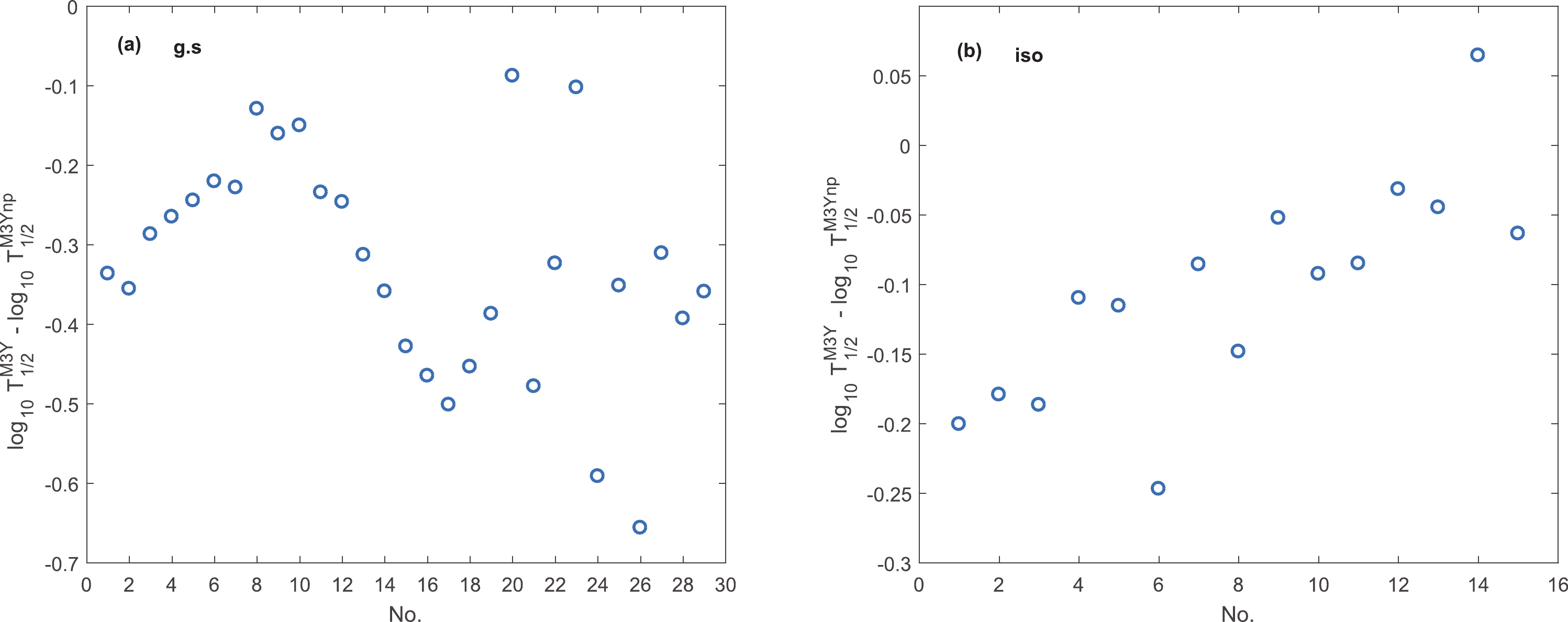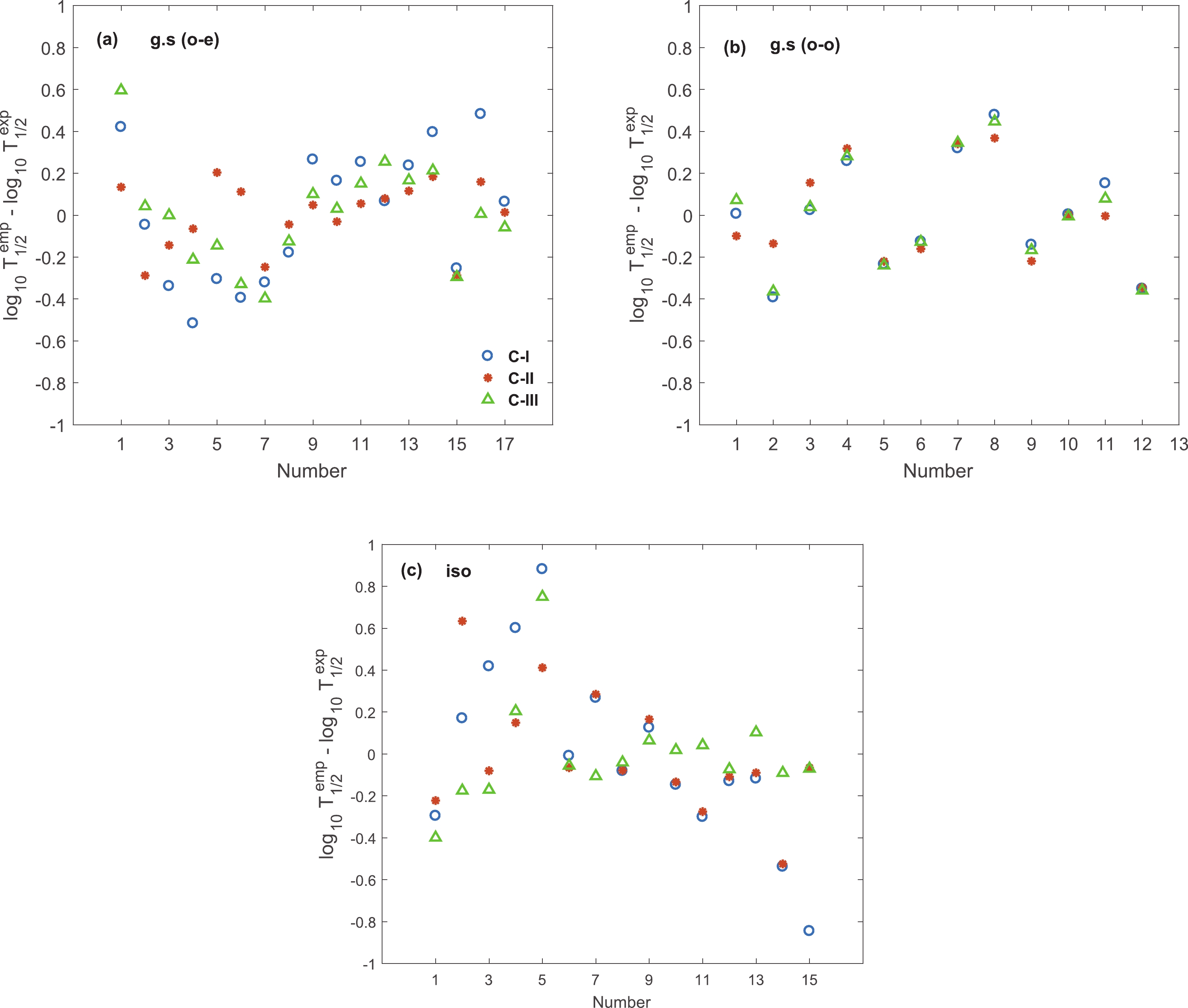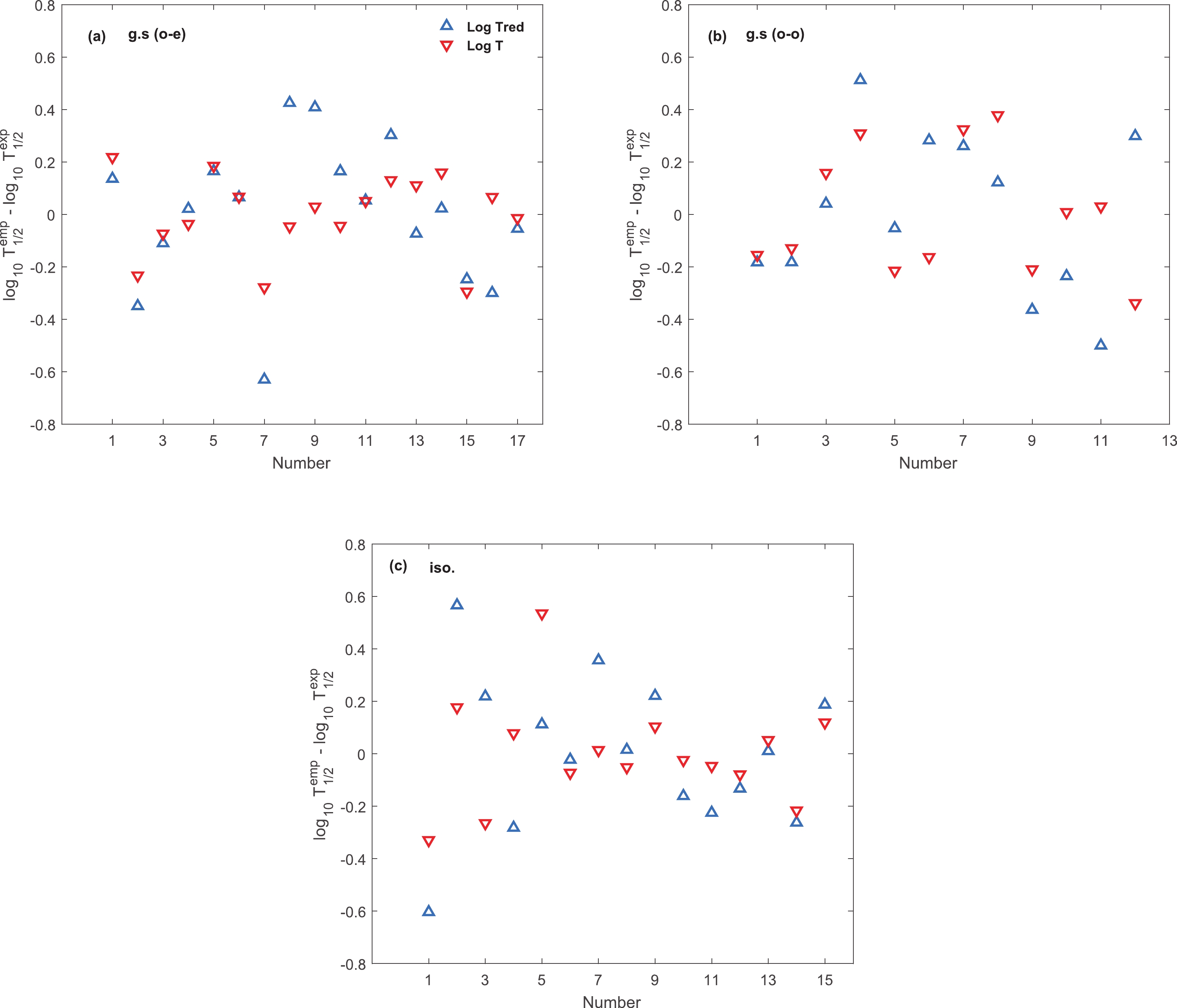HTML
--> --> -->The nuclear deformation and the asymmetry parameter are two important properties in the study of nuclear decay. In different theoretical models for the calculation of proton emission half-lives, the nuclear deformation has been included directly through explicit dependence on the Coulomb and nuclear potentials [10-13]. Moreover, the nuclear asymmetry parameter has been included in the nuclear potential and spectroscopic factor [14-17]. The proton emission empirical formula is basically a function of the Q-value of proton emission and the atomic number of the daughter nucleus. The formula may comprise the nuclear properties of parent or daughter nuclei, such as orbital angular momentum and deformation parameters, through microscopic foundations or the introduction of new modification terms. The dependence of the empirical half-life on these additional terms may be justified based on microscopic or macroscopic theoretical calculations. The first empirical formula in this regard introduced an implicit function of deformation and momenta [1]. An empirical formula as a function of deformation has been given in Ref. [18]. The effects of deformation and Q-value on empirical formulae have been investigated in our previous work [19]. This motivated us to assess the effect of deformation and the asymmetry parameter, separately as well as together, on two forms of empirical formula. Using the single-folding potential [20, 21] and adopting asymmetry parameter dependent densities, the influence of the asymmetry parameter on calculated half-lives can be evaluated.
In Sec. II, the theory related to our calculations is given in two parts, theoretical calculations and empirical formulas. The results of our calculation are given in Sec. III. Finally, the conclusion and summary are presented in Sec. IV.
2
A.Theoretical half-life
The effective interaction potential between a proton and daughter nucleus, $ V_{\rm eff}(r) = V_N(r)+V_{\rm C}(r)+V_l(r), $  | (1) |
The nuclear potential can be calculated through the single folding model,
$ V_{N}(r) = \int {\rm d}\vec{r}_1 \rho(\vec{r}_1) v(s) , $  | (2) |
$ v(s) = 7999 \frac{{\rm e}^{-4s}}{4s}-2134 \frac{{\rm e}^{-2.5s}}{2.5s}-276\delta(s). $  | (3) |
$ \rho(r) = \frac{\rho_0}{1+\exp\left[\dfrac{r-R}{a}\right]}. $  | (4) |
$ \begin{aligned}[b]&R_p = 1.249 A^{1/3}-0.5401-0.9582\; I,\\&R_n = 1.2131 A^{1/3}-0.4415+0.8931 \; I,\\&a_p = 0.4899-0.1236 \;I,\\& a_n = 0.4686+0.0741 \; I,\end{aligned} $  | (5) |
$ V_N(r) = V^n_N(r)+V^p_N(r) = \int {\rm d}\vec{r}_1 \rho_n(\vec{r}_1) v(s)+\int {\rm d}\vec{r}_1 \rho_p(\vec{r}_1) v(s), $  | (6) |
The Coulomb potential
The proton emission half-life can be calculated through the WKB approximation. The two necessary conditions of the WKB for the centrifugal term and nuclear potential, respectively, are the Langer modification and Bohr
$ V_{\rm eff}(r) = \eta V_N(r)+ V_{\rm C}(r)+\dfrac{\hbar^2\left(l+\dfrac{1}{2}\right)^2}{2\mu r^2} ,$  |
In Ref. [28] the asymmetry dependence of the nuclear potential has been investigated by adding the Lane potential [29] to the nuclear potential
The proton emission half-life is calculated as
$ T_{1/2} = \frac{\ln 2}{\nu P S_p}, $  | (7) |
$ \begin{aligned}[b]&\nu = \frac{\hbar}{2\mu}\left[\int^{r_2}_{r_1}\dfrac{{\rm d}r}{\sqrt{\dfrac{2\mu}{\hbar^2}|Q-V_{\rm eff}(r)}|} \right]^{-1},\\&P = \left[1+\exp\left(\frac{2\sqrt{2\mu}}{\hbar}\int^{r_3}_{r_2}{\rm d}r \sqrt{V_{\rm eff}(r)-Q}\right)\right]^{-1} ,\end{aligned} $  | (8) |
The spectroscopic factor is a crucial quantity for theoretical calculations, and different microscopic methods have been used for its calculation. For example, Lalazissis et al. [31] have used the relativistic Hartree-Bogoliubov approach to calculate the spectroscopic factor for proton emission. In Ref. [14] the spectroscopic factors of 27 proton emitters have been calculated through relativistic mean field approach (RMF) theory combined with the BCS method with the force NL3. We have followed a similar approach. As pointed out in Ref. [31], the spectroscopic factor for proton emission from a particular level in the parent nucleus may be estimated by the non-occupancy of the level in the daughter nucleus.
2
B.Empirical half-life
The empirical formulas, in spite of their common structure being based on the explicit dependence of the atomic number and inverse square-root Q-value, can be modified by adding new terms as functions of the basic structure of the emitter or daughter nuclei. Further, the formulas may be explicit or implicit functions of angular momentum l. The reduced half-life, $ \log_{10} T_{1/2}^{\rm red} = a\mu^{1/2}Z_d Q^{-1/2}+b\mu^{1/2}Z_d+c+d|\beta_2^3|, $  | (9) |
A recently introduced formula, with explicit and strict dependence on angular momentum, is written as [32]
$ \log_{10} T_{1/2} = [al+b]Z_d^{0.8} Q^{-1/2}+[cl+d]. $  | (10) |
$ \log_{10} T_{1/2}^{\rm red} = a\mu^{1/2}Z_d Q^{-1/2}+b\mu^{1/2}Z_d+cI+d\beta_2^4+e, $  | (11) |
$ \log_{10} T_{1/2} = [al+b]\,Z_d^{0.8} Q^{-1/2}+[cl+d]+eI+f\beta_2^4. $  | (12) |
The root-mean-square
$ \sigma = \sqrt{\frac{1}{n}\sum\limits_{i = 1}^{n}[\log_{10} T_{1/2}^{\rm exp.}(i)-\log_{10} T_{1/2}^{\rm cal.}(i)]^2}. $  | (13) |
The asymmetry parameters of parent (
 Figure1. (color online) Asymmetry parameter of parent and daughter nuclei for (a) ground state and (b) isomeric transitions. The numbers correspond to the nuclei in Table 1.
Figure1. (color online) Asymmetry parameter of parent and daughter nuclei for (a) ground state and (b) isomeric transitions. The numbers correspond to the nuclei in Table 1.Using asymmetry parameter dependent densities in Eq. (4), nuclear potential and evidently decay half-life are the functions of this factor. Figure 2 (a) and (b) show the deviation between calculated half-lives with and without including the asymmetry factor for ground state and isomeric transitions. This comparison is independent of the value of spectroscopic factor
 Figure2. (color online) Difference between calculated half-lives with and without nuclear asymmetry parameter.
Figure2. (color online) Difference between calculated half-lives with and without nuclear asymmetry parameter.As already mentioned, spectroscopic factors for proton emission can be estimated by the non-occupation probability of the relevant level in the daughter nucleus. These values have been calculated in the RMF+BCS formalism. The computer code DIZ [35], extended for odd particle numbers in Ref. [36], has been employed. We have employed two standard parameters, NL1 [37] and NL3 [38], for RMF calculation. A constant pairing gap approach has been assumed, with the values of the pairing gap being estimated from the experimental odd-even mass difference, if available, or its corresponding estimate from semi-microscopic binding energy values. Obtained values for spectroscopic factors are presented in Table 1. Except in some cases for isomeric transition, NL1 and NL3 give similar results. Many of the daughter nuclei are found to be nearly spherical at low energy, and these have been indicated in the table.
| No. | Parent |   |   | No. | Parent |   |   |
| 1 |   | 0.838 | 0.789 | 1 |   | 0.505 | 0.658 |
| 2 |   | 0.584 | 0.753 | 2 |   | 0.923 | 0.905 |
| 3 |   | 0.571 | 0.741 | 3 |   | 0.331 | 0.508 |
| 4 |   | 0.743 | 0.744 | 4 |   | 0.702 | 0.817 |
| 5 |   | 0.911 | 0.907 | 5 |   | 0.622 | 0.737 |
| 6 |   | 0.697 | 0.852 | 6 |   | 0.496 | 0.401 |
| 7 |   | 0.678 | 0.844 | 7 |   | 0.387 | 0.303 |
| 8 |   | 0.868 | 0.829 | 8 |   | 0.376 | 0.272 |
| 9 |   | 0.745 | 0.645 | 9 |   | 0.245 | 0.163 |
| 10 |   | 0.747 | 0.650 | 10 |   | 0.771 | 0.620 |
| 11 |   | 0.558 | 0.418 | 11 |   | 0.789 | 0.641 |
| 12 |   | 0.918 | 0.898 | 12 |   | 0.137 | 0.086 |
| 13 |   | 0.923 | 0.905 | 13 |   | 0.43 | 0.087 |
| 14 |   | 0.685 | 0.596 | 14 |   | 0.056 | 0.083 |
| 15 |   | 0.753 | 0.671 | 15 |   | 0.986 | 0.985 |
| 16 |   | 0.737 | 0.648 | ||||
| 17 |   | 0.509 | 0.402 | ||||
| 18 |   | 0.459 | 0.651 | ||||
| 19 |   | 0.681 | 0.812 | ||||
| 20 |   | 0.678 | 0.730 | ||||
| 21 |   | 0.402 | 0.549 | ||||
| 22 |   | 0.609 | 0.768 | ||||
| 23 |   | 0.339 | 0.475 | ||||
| 24 |   | 0.576 | 0.713 | ||||
| 25 |   | 0.745 | 0.845 | ||||
| 26 |   | 0.339 | 0.339 | ||||
| 27 |   | 0.531 | 0.660 | ||||
| 28 |   | 0.296 | 0.408 | ||||
| 29 |   | 0.291 | 0.414 |
Table1.Spectroscopic factor of proton emitters. Daughters of nuclei marked with '
Using assault frequency and tunneling probability as functions of the asymmetry parameter and calculated values of spectroscopic factor, the proton emission half-lives are obtained. The difference between calculated half-lives and experimental values for ground state and isomeric transitions can be observed in Fig. 3(a) and (b), respectively. The obtained half-lives are in good agreement with experiment.
 Figure3. (color online) Difference between calculated half-lives and experimental data for (a) ground state and (b) isomeric transitions. M3Ynp (NL1) and M3Ynp (NL3) stand for calculated half-lives with asymmetry parameter and spectroscopic factor with the RMF+BCS model.
Figure3. (color online) Difference between calculated half-lives and experimental data for (a) ground state and (b) isomeric transitions. M3Ynp (NL1) and M3Ynp (NL3) stand for calculated half-lives with asymmetry parameter and spectroscopic factor with the RMF+BCS model.The adjustable parameters of the empirical formulas and corresponding rms errors are given in Tables 2 and 3. Table 2 presents the fitted parameters for the empirical formula for
| Transition | Parameters |   | Parameters |   | Category |
| Ground | (0.432, ?2.138, ?13.701) | 0.4578 | (0.430, ?2.371, ?11.644) | 0.4678 | |
| (0.439, ?1.668, ?18.073) | 0.3507 | ||||
| Isomeric | (0.384, ?0.664, ?23.242) | 0.3505 | (I) | ||
| (0.409, ?1.955, ?13.698) | 0.4997 | ||||
| All | (0.413, ?1.833, ?14.985) | 0.4822 | (0.422, ?1.485, ?18.578) | 0.3943 | |
| Ground | (0.434, ?1.791,89.210, ?16.903) | 0.3593 | (0.428, ?1.910, 116.136, ?15.609) | 0.2669 | |
| (0.444, ?1.462, 52.092, ?20.184) | 0.3152 | ||||
| Isomeric | (0.377, ?0.702, 77.508, ?22.606) | 0.2999 | (II) | ||
| (0.407, ?1.5091, 115.878, ?16.877) | 0.3330 | ||||
| All | (0.414, ?1.509, 94.610, ?18.013) | 0.3899 | (0.427, ?1.251, 57.189, ?20.987) | 0.3667 | |
| Ground | (0.464, ?0.819, ?42.578, ?24.286) | 0.4176 | (0.481, ?0.210, ?70.55, ?28.747) | 0.3458 | |
| (0.498,1.132, ?80.948, ?40.760) | 0.2944 | ||||
| Isomeric | (0.345, ?2.464, 39.942, ?8.140) | 0.2870 | (III) | ||
| (0.405, ?2.197, 6.836, ?11.832) | 0.4982 | ||||
| All | (0.409, ?2.031, 5.643, ?13.447) | 0.4812 | (0.484, 1.535, ?85.279, ?42.966) | 0.3306 | |
| Ground | (0.433, ?1.816, 0.881,90.028, ?16.714) | 0.3593 | (0.425, ?1.987, 2.939, 119.431, ?15.009) | 0.2668 | |
| (0.489, 0.714, ?66.927, 17.012, ?37.520) | 0.2919 | ||||
| Isomeric | (0.353, ?2.001,29.3195, 31.020, ?11.902) | 0.2828 | (IV) | ||
| (0.399, ?2.044, 13.012, 118.035, ?13.383) | 0.3249 | ||||
| All | (0.407, ?1.944, 12.666, 97.60, ?14.658) | 0.3838 | (0.479, 1.325, ?77.883, 12.827, ?41.385) | 0.3295 |
Table2.Parameters for the empirical formula for
| Transition | Parameters |   | Parameters |   | Category |
| Ground | (0.032, 0.825, ?0.151, ?26.545) | 0.3505 | (0.047, 0.819, ?0.540, ?26.219) | 0.3091 | |
| (0.022, 0.852, 0.202, ?27.686) | 0.2564 | ||||
| Isomeric | (0.120, 0.337, ?2.404, ?14.061) | 0.4220 | (I) | ||
| (0.032, 0.840, ?0.144, ?26.903) | 0.4183 | ||||
| All | (0.023, 0.845, 0.109, ?27.176) | 0.3976 | (0.002, 0.935, 0.761, ?30.084) | 0.2549 | |
| Ground | (0.014, 0.908, 0.374, ?29.085, 65.348) | 0.2680 | (0.024, 0.896, 0.091, ?28.630, 75.488) | 0.1555 | |
| (0.006, 0.937, 0.663, ?30.197, 35.209) | 0.2321 | ||||
| Isomeric | (0.142, 0.211, ?2.782, ?11.848, 215.944) | 0.2783 | (II) | ||
| (0.008, 0.935, 0.545, ?29.881, 88.050) | 0.3142 | ||||
| All | (0.005, 0.933, 0.641, ?29.88, 73.00) | 0.3286 | (-0.010, 1.002, 1.107, ?32.069, 37.513) | 0.2317 | |
| Ground | (0.011, 0.936, 0.446, ?29.073, ?10.909) | 0.3161 | (0.020, 0.949, ?29.116, ?14.129) | 0.2386 | |
| (0.014, 0.892, 0.415, ?28.659, ?2.604) | 0.254 | ||||
| Isomeric | (0.235, ?0.221, ?5.431, ?1.379, 28.833) | 0.2414 | (III) | ||
| (0.026, 0.869, 0.020, ?27.423, ?4.809) | 0.4091 | ||||
| All | (0.019, 0.867, 0.221, ?27.596, ?3.029) | 0.3945 | (-0.004, 0.967, 0.927, ?30.859, ?2.448) | 0.2530 | |
| Ground | (0.011, 0.924, 0.456, ?29.407, ?2.271, 60.099) | 0.2667 | (0.019, 0.923, 0.222, ?29.139, ?3.944, 66.096) | 0.1492 | |
| (0.009, 0.919, 0.564, ?29.790, 1.780, 38.753) | 0.2312 | ||||
| Isomeric | (0.213, ?0.123, ?4.736, ?3.954, 20.271, 116.391) | 0.1990 | (IV) | ||
| (0.009, 0.933, 0.534, ?29.856, 0.620, 89.305) | 0.3140 | ||||
| All | (0.008, 0.916, 0.559, ?29.578, 37.856, 81.051) | 0.3215 | (-0.005, 0.974, 0.964, ?31.484, 3.142, 45.284) | 0.2293 |
Table3.Same as Table 2, but for
The adjustable parameters of the empirical formula
Moreover, comparison between the two empirical formulas shows that, except for the isomeric transition formula in the first category, using Eq. (12) for
In order to evaluate the contribution of nuclear deformation and asymmetry parameter terms in the empirical formula for
 Figure4. (color online) Difference between calculated and experimental half-lives with parameters of Table 3. The numbers in (a) and (b) correspond to the odd-even and odd-odd nuclei in Table 1.
Figure4. (color online) Difference between calculated and experimental half-lives with parameters of Table 3. The numbers in (a) and (b) correspond to the odd-even and odd-odd nuclei in Table 1.Figure 5 (a)-(c) shows the difference between experimental data and calculated half-lives of ground state odd-even, odd-odd, and isomeric transitions with the lowest rms, category IV, for both the empirical formulas. These figures clearly show that inclusion of both deformation and asymmetry terms effectively reduces the deviation between empirical results and experiment, as well as indicating the crucial role of the deformation and asymmetry terms. Very good agreement between theory and experiment is observed, especially for the second form of empirical formula
 Figure5. (color online) Difference between calculated and experimental half-lives for the formula with the lowest rms error, category IV.
Figure5. (color online) Difference between calculated and experimental half-lives for the formula with the lowest rms error, category IV.The remarkable contribution of the asymmetry parameter in theoretical calculations justifies the explicit presence of a correction term as a function of asymmetry parameter in empirical formulas. The dependence of two forms of empirical formulas on the asymmetry term have been investigated in different categories of transitions and specialized divisions of odd-even and odd-odd ground state and all transitions. The inclusion of this modification can reduce the rms errors in all cases, and for isomeric and odd-even and odd-odd ground state transitions the reduction is very apparent, especially for the second type of empirical formula, in which the rms error reaches about 0.2 (corresponding to a 43% relative reduction). The data has been fitted for the quadrupole deformation term separately and, as expected, very good results have been obtained. Therefore, the presence of both deformation and asymmetry terms in empirical formulas have been evaluated and the lowest rms error values have been achieved for both formulas. The rms error has been brought down to less than 0.2 for the isomeric and ground state odd-even transitions, and better agreement between theory and experiment is observed for the second type of formula, with explicit dependence on angular momentum, deformation, and asymmetry parameter.
